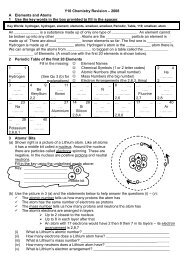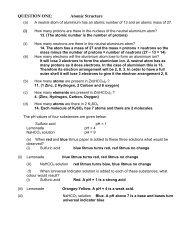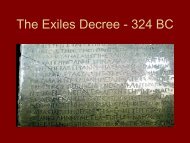Physics Answers
Physics Answers
Physics Answers
Create successful ePaper yourself
Turn your PDF publications into a flip-book with our unique Google optimized e-Paper software.
QUESTION NINE: MOTION-TIME GRAPHS<br />
A passenger training for a harbour swim boards a ferry that travels<br />
from wharf A across the harbour to wharf B.<br />
The ferry leaves wharf A and slowly accelerates. It takes 150 s to<br />
travel the first 500 m. The ferry then travels the next 2000 m at a<br />
constant speed. This section of the journey takes 300 s. The ferry<br />
decelerates over the final 500 m, taking a further 150 s.<br />
(a)<br />
Sketch a distance-time graph for the ferry’s journey.<br />
(b) (i) Calculate the average speed of the ferry during the<br />
journey.<br />
The same passenger then dives off wharf B and swims across the<br />
harbour to the far shore as shown in the speed-time graph below.<br />
Speed<br />
(ms -1 )<br />
0.8<br />
0<br />
Section<br />
A<br />
Speed-time graph for swim across the<br />
harbour<br />
Section<br />
B<br />
400 4000<br />
Section<br />
C<br />
(b) (ii) Calculate the distance the person swam while her<br />
speed was changing.<br />
Time (s)<br />
(c) Discuss whether the forces on the swimmer are balanced or<br />
unbalanced during each section of the swim and how this results in<br />
the types of motion produced.<br />
4500<br />
QUESTION NINE ANSWER: MOTION-TIME GRAPHS<br />
a) Plotting graph correctly and drawing of correct graph shapes:<br />
3000<br />
2500<br />
tra<br />
vell<br />
ed<br />
(m)<br />
500<br />
b) (i) Calculation<br />
0<br />
of average<br />
1 2<br />
speed:<br />
3 4<br />
v = d/t<br />
5 6<br />
= 3000/600 = 5 m s -1<br />
(ii) Calculation of distance:<br />
0<br />
Only<br />
0<br />
applies<br />
0<br />
to<br />
0<br />
section e 0<br />
A and<br />
0<br />
C<br />
Area of section A: 0.5 x<br />
0<br />
400<br />
0<br />
x 0.8<br />
0<br />
= 160<br />
0<br />
m (sec 0 0<br />
Area of section C: 0.5 x 500 x 0.8 = 200 m onds<br />
Total distance = total area 160 + 200 ) = 360 m<br />
c) Explanation of motion:<br />
Section A: Forces are unbalanced; there is a net force in the forward direction causing the<br />
swimmer to accelerate.<br />
Section B: Forces are balanced; there is zero net force, therefore swimmer moving at<br />
constant speed.<br />
Section C: Forces are unbalanced; there is a net force in the backward direction causing<br />
the swimmer to decelerate.<br />
For Achievement your answer should have two of:<br />
in (a), completes the graph accurately showing correct graph shapes for at least two<br />
sections (with the y axis labelled correctly).<br />
in (b), attempts to calculate average speed (E.g. writes the formula and substitutes<br />
values OR finds average speed but does not give the unit). AND recognises the distance<br />
as the area under the speed-time graph (E.g. attempt made at finding an area of any of<br />
the three sections).<br />
in (c), shows understanding that section B represents constant speed and A and C<br />
represent changing speed.<br />
In (c) correctly states whether forces are balanced or unbalanced for each section.<br />
For Merit your answer should have two of:<br />
in (a), draws accurate graph with appropriate shapes for all three sections<br />
in (b), calculates average speed correctly (with unit) AND calculates the area under at<br />
least one section of the graph and states the distance.<br />
in (c), states whether the forces are balanced or unbalanced for two sections of the<br />
graph AND links them to the motion. (balanced = constant speed, unbalanced =<br />
acceleration)<br />
For Excellence your answer should have everything

















